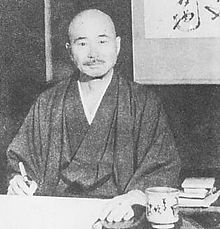Inoue Nisshō
Inoue Nisshō ( Japanese 井上 日 召 ; * April 12, 1887 in Kawaba , Gunma Prefecture ; † March 2, 1967 ) was a self-proclaimed Buddhist preacher , Japanese nationalist and representative of Nichirenism . He headed a group of right-wing terrorists in the 1930s.
biography
He was born under the name Shirō Inoue as the son of a country doctor in 1887. His older brother Inoue Fumio (1883-1919) was a marine who died in an accident at work. Inoue began his training at the technical college of Tōyō Kyōkai (now Takushoku University ). After abandoning his studies, he went to Manchuria , where, after a life as a hobo from 1909 to 1920 for the South Manchuria Railway was working. After returning to Japan , he first joined Zen Buddhism and finally converted to Nichiren Buddhism . Under the guidance of the nationalist Tanaka Chigaku he studied at his "Academy" belonging to the Kokuchūkai . After falling out with Tanaka, he founded his own "temple", the Risshō Gokokudō ( 立正 護 国 堂 , "Temple for the Defense of National Justice"). At this point it should be noted that Nisshō Inoue is often referred to as a Nichiren priest, but he never went through an ordination. His theses were rejected by the traditional schools of Nichiren Buddhism.
Due to his proximity to Naidaijin Tanaka Mitsuaki , he made the acquaintance of leading nationalists of his time such as Ōkawa Shūmei and Kita Ikki . The increasing radicalization of Inoue led to the founding of the Ketsumeidan in 1930. With the aim of eliminating the country's economic and political elite, Inoue was involved in the attacks on the former finance minister Inoue Junnosuke and the director of the Mitsui Group Dan Takuma . These events are also known as the Ketsumeidan Incident . The activities of the Ketsumeidan reached another high point with the assassination of Prime Minister Inukai Tsuyoshi , also known as the Incident on May 15 , in 1932 (Inoue had already been arrested by then).
Inoue Nisshō was sentenced to life imprisonment along with three of his accomplices in 1934, but pardoned in 1940. As a recognized fascist, he was banned from public life by the American military government in 1947. After the end of the occupation he took an active part in political life as a nationalist until his death in 1967.
Sources and individual references
- ↑ Hori, Inoue Nissho . Page 178
- Brian Victoria: Zen Terror. Aeon.co, July 10, 2019
literature
- Makiyo Hori: 「井上 日 召 と" か ぎ の 折伏 ": 血盟 団 事件 に つ い て」 ( Inoue Nissho and his Terrorist Ideas: Some Notes on the Oath of Blood Group ), in: The Waseda Journal of Political Science and Economics ( 早 稲 田 政治経 済 学 雑 誌 ), 328, 1996.
- Hideo Kobayashi: 「井上 日 召 の 思想 と 行動 : 日本 フ ァ シ ス ト の 一 類型」 ( The Thoughts and Activities of Inoue Nissho: A Model for Japanese Fascists ), in: Rekishi Hyōron ( 歴 史 評論 ), 400, 1983.
- Stephen S. Large: Nationalist Extremism in Early Showa Japan: Inoue Nissho and the 'Blood-Pledge Corps Incident', 1932 , in: Modern Asian Studies 35: 3 (2001).
- One Hundred Million People's Showa History from Father to Child - Modern Biographical Histories ( 父 が 子 に 送 る 一 億 人 の の 昭和 史 : 人物 現代史 ), Mainichi Shimbun Press, 1977.
| personal data | |
|---|---|
| SURNAME | Inoue, Nisshō |
| ALTERNATIVE NAMES | 井上 日 召 (Japanese); Inoue Shirō (real name) |
| BRIEF DESCRIPTION | Japanese Buddhist preacher and nationalist |
| DATE OF BIRTH | April 12, 1887 |
| PLACE OF BIRTH | Kawaba , Gunma Prefecture |
| DATE OF DEATH | March 2, 1967 |
